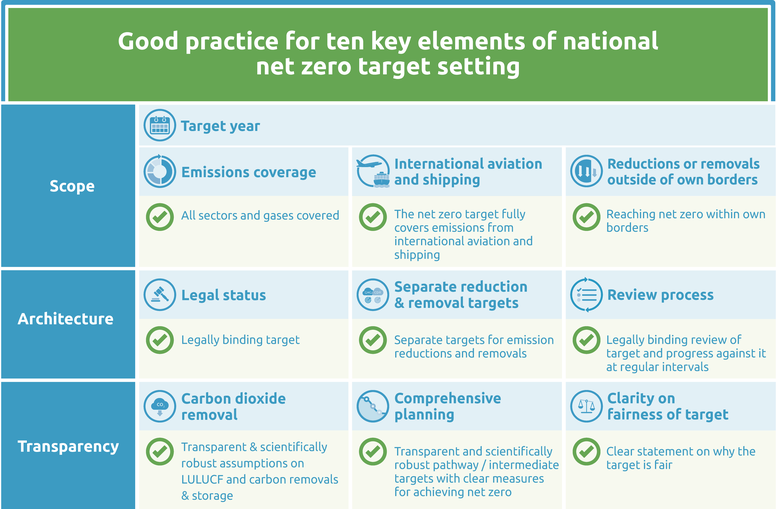Net zero targets
Summary
We evaluate Nepal’s net zero target as: Average
At COP26, Nepal announced its commitment to carbon neutrality by or before 2045. The government submitted its Long-Term Strategy which outlines two GHG mitigation scenarios: the WAM (with additional measures) and the WEM (with existing measures) for achieving carbon neutrality by or before 2045 (Government of Nepal, 2021). The targets mentioned in the LTS are conditional upon receiving climate financing.
The WEM scenario is based on existing plans and policies, highlighting the energy sector as the main CO2 removal strategy. Despite this, the scenario relies on the LULUCF sink to mitigate emissions for the first 10 years. Strategic measures in the agriculture and waste sectors cover CO2 and non-CO2 reduction targets. In the IPPU sector, no intervention will be made.
On the other hand, the WAM scenario introduces ambitious intervention in the energy sector including the use of fuel cells, biofuel, green hydrogen, and CCUS. This pathway relies heavily on decreasing emissions from the energy sector, while maintaining the LULUCF sector’s carbon sink potential. In this scenario, net CO2 emissions are projected to remain negative from 2020 to 2030, and increase to around ‘zero’ between 2035 to 2045, and then sink to negative by 2050. This scenario aims to pave the way towards carbon neutrality sooner than 2045 (Government of Nepal, 2021).
Both scenarios cover energy efficiency improvement, fuel switching and a strong target for electrification across most sectors. The LTS also put targets on promoting agroforestry and efficient agricultural practices. However, the WEM scenario will not lead to the achievement of the carbon neutrality target while WAM scenario does. It is also unclear to what extent the government will rely on CDR technology and which scenario the government is committed to achieving.
The scenarios above are national scenarios. However, the government argues that it is feasible to achieve net zero emissions sooner than 2045 through cross-border energy trade. Thus, the LTS projected additional scenario, where both domestic scenarios are combined with a 50% energy trade, shows that Nepal could be carbon negative by 2030 (Government of Nepal, 2021).
To improve its net zero target rating, the government of Nepal could clarify the scope and target architecture, as well as enhance its transparency. For instance, the government would need to: cover all GHG emissions in its net zero emission scenario, explicitly include emissions from international aviation and establish a binding review cycle.
CAT analysis of net zero target
Scope
- Target year – Nepal aims to be carbon neutral by 2045 or sooner and achieve negative carbon emissions by 2050.
- Emissions coverage – The long-term strategy sets out targets that cover all sectors of the economy: energy, industry process, agriculture, forestry and land use, and waste. However, the LTS only covers CO2 emissions despite non-CO2 emissions representing 70% of Nepal's total emissions (excl. LULUCF) in 2021 (Gütschow, Günther and Pflüger, 2022). Nepal’s second NDC makes reference to ‘net-zero greenhouse gas emission by 2050’ and clearly states all sectors and emissions (CO2, CH4 and N2O) are covered.
- International aviation and shipping – In its LTS, Nepal makes reference to shifting fuel to clean energy in aviation to reduce CO2 emissions from the transport sector. We assume that the target only covers domestic aviation. Nepal would need to explicitly include emissions from international aviation to upgrade the rating.
- Reductions or removals outside of own borders – Nepal’s LTS provides a preliminary analysis of the carbon offset potential based on hydropower generation. It also highlights a potential scenario for clean energy trade combined with the WEM and WAM scenarios; which is projected to drive Nepal to be carbon-negative significantly faster (Government of Nepal, 2021). However, Nepal only plans to sell offsets, but does not aim to use external offsets to meet its own carbon neutrality target.
Target architecture
- Legal status – Nepal first announced its net zero target at COP26 to be cumulatively ‘net zero carbon’ from 2022-2045 and ‘carbon negative’ after that. In October 2021, Nepal submitted its long-term strategy (LTS) to the UNFCCC including its ‘carbon neutrality’ target for 2045. Neither target has been enshrined into policy or law as of March 2023.
- Separate reduction & removal targets – Nepal provides separate emissions reduction and removal targets. It sets LULUCF emissions targets of -9.2 and -0.7 MtCO2 by 2050 for the WAM and WEM scenarios, respectively. The LTS does not specify the role of carbon removal in its carbon neutrality scenarios.
- Review process – The implementation of the targets will be evaluated against performance indicators compatible with national targets. The indicators will be updated biennially, linear with the government’s GHG inventory report (Government of Nepal, 2021). Nepal needs to provide a legally binding review cycle to improve the rating.
Transparency
- Carbon dioxide removal – Nepal's long-term strategy sets out LULUCF as the main removal strategy for the first 10 years under a minimum intervention scenario.
- Comprehensive planning – Nepal provides sectoral plans and targets for 2030 and 2050 within its net zero scenarios (Government of Nepal, 2021). The LTS mentions briefly CDR technology as a necessary intervention in the WAM scenario, but no further information is provided.
- Clarity on fairness of target – Nepal provides no information on its intention to explain the target’s fairness.
Good practice
The Climate Action Tracker has defined the following good practice for all ten key elements of net zero targets. Countries can refer to this good practice to design or enhance their net zero targets.
Further analysis
Latest publications
Stay informed
Subscribe to our newsletter







